Last Updated on October 24, 2023
Welcome to a bottomless, boundless ocean of adventure — of strangeness, terror, and whimsy. This is the space between the Forgotten Realms and Greyhawk, between the world of Dark Sun and Mystara.
Board your spacefaring galleon carved from the skull of a dead god, the carcass of a space whale, or a giant scorpion, and set sail for Wildspace — the expanse between the stars before you get all the way to the Astral plane. Welcome to a realm of cities built on asteroids, wonders like pods of gargantuan celestial whales, and terrors — like mind flayer pirates prowling through the infinite void aboard living, tentacled spaceships.
Welcome to Spelljammer.

*Hawkwind intensifies*
With the Dungeons & Dragons 5e reboot of the classic 1980s campaign setting finally released, we wanted to give you a crash course in the Spelljammer setting. In this guide, we’re going to break down how Spelljammer fits into the wider D&D multiverse, how to have adventures there, and what kind of weirdness you can expect to encounter when you book passage beyond The Forgotten Realms.
What Is Spelljammer?
First released in 1989 for Advanced Dungeons & Dragons 2e, Spelljammer is an iconic D&D setting that allows heroes to have adventures in space, sailing between strange and wondrous worlds on magical ships called spelljammers. Heroes in the Spelljammer setting can meet humanoid hippo-folk, sentient oozes, and vast colony ships filled with beholders.
In 5e, the setting explores Wildspace — the void beyond the various worlds of D&D — and the Astral Plane beyond, providing six new playable races, new spells, monsters, factions, locations, and of course Spelljammer Ships.
Welcome to Wildspace: A Quick Guide to Spacefaring
Before we set sail between luminous nebulae and collapsing stars, we should cover the basics. We need to know simple stuff like what the difference is between Wildspace and the Astral Sea, how gravity works, and how the heck everyone can still breathe out here.
The first thing we should do is define some terms.
Every world — whether it be a globe, a cube, a screaming mass of disembodied limbs, or flat and carried through space on the back of a celestial turtle — is surrounded by a void known as Wildspace. This airless void can also contain suns, moons, comets, giant monsters, or other celestial bodies that include additional worlds.
One or more worlds grouped together in Wildspace is called a Wildspace System. When you reach the edge of a Wildspace system, you start to see a faint silvery haze that grows more opaque the farther you travel. Go far enough, and you’ll end up leaving your world behind altogether.
Wildspace is an unquestionably scary place, but it’s not all airless void and ravenous interstellar monstrosities, however. There are plenty of intelligent races (native or otherwise) that make their home on the Astral Plane. Some live nomadic lives aboard their ships while others flock to strange and wondrous cities like the Rock of Bral, a huge, cosmopolitan city built on an asteroid and widely considered to be the crossroads of Wildspace.
In Wildspace, the Prime Material Plane (the “mundane” world at the heart of every D&D universe) overlaps and intersects with the Astral Plane — the realm of stars and portals to “the heavens” and the infinite void.
Passing beyond Wildspace into the Astral Plane takes you to the Astral Sea — a vast, silver ocean dotted with stars. Like Wildspace, the Astral Sea is mostly an empty void, although unlike material space, it isn’t airless. Beings traveling the Astral sea never run out of air and never need to eat, drink, or sleep — although fishing is still a common pastime.
Ships (or, in fact, lone creatures) here don’t need wind in their sails or magic to move through the Silver Void; an intelligent creature can move through the Astral Sea simply by focusing their mind on their destination. Although it is possible to travel the Astral Plane propelled purely by your own thoughts (powerful beings like the wizard Mordenkainen and the demilich Acererak do it regularly), most sailors on the seas of stars choose to do so in well-defended ships.
These ships, called Spelljammers, are necessary for safe (ish) travel in both Wildspace and on the Astral Sea, for there are many dangerous races and monsters that make their home out here. There are many strange natural hazards — from collapsing stars and fragments of wild magic to the petrified hulks of dead gods and swirling pools of color that can transport you to other planes of existence.
A spelljamming ship is piloted using a wondrous item called a Spelljamming Helm, a magical chair used to psychically link a ship capable of sailing through space with its pilot — who is also called a Spelljammer. This process is called spelljamming.
What Is Spelljamming?
The act of Spelljamming involves using a Spelljamming Helm to pilot a ship through Wildspace, the Astral Plane, or even the material world. Attuning to a Spelljamming Helm allows a pilot to maneuver their ship through space, operating it like an extra limb.
When a spelljamming ship flies through space, it can reach a comfortable cruising speed of about 4 million miles per hour. Thankfully, the magic in the Spelljamming Helm ensures that ships can steer themselves around minor obstacles and safely slow to a halt when the ship is about to run into something big, like another ship, a planet, or a pod of Kindori (giant space whales).
Air Envelopes
When creatures and large objects exit a planet’s atmosphere and enter Wildspace, they bring an envelope of breathable air with them. This is how adventurers can stand on the open decks of spelljamming ships as they sail through the void of space.
These envelopes of breathable air last until they are depleted, and both their size and how long they last depend on the size of the creature or object they surround. A size-medium human, for example, carries a 5×5-foot cube of air with them when they leave a planet’s atmosphere or an air envelope.
Any creature by itself in the vacuum of Wildspace will exhaust its personal Air Envelope in a minute, after which they have to hold their breath and eventually begin choking. This is why most creatures travel through WIldspace aboard spelljamming ships, which have air envelopes large enough to keep their crews alive for over 200 days — although the air on board becomes “foul” after about 120 days. Also, a ship carrying more than its complement of crew will exhaust its air supply much faster.
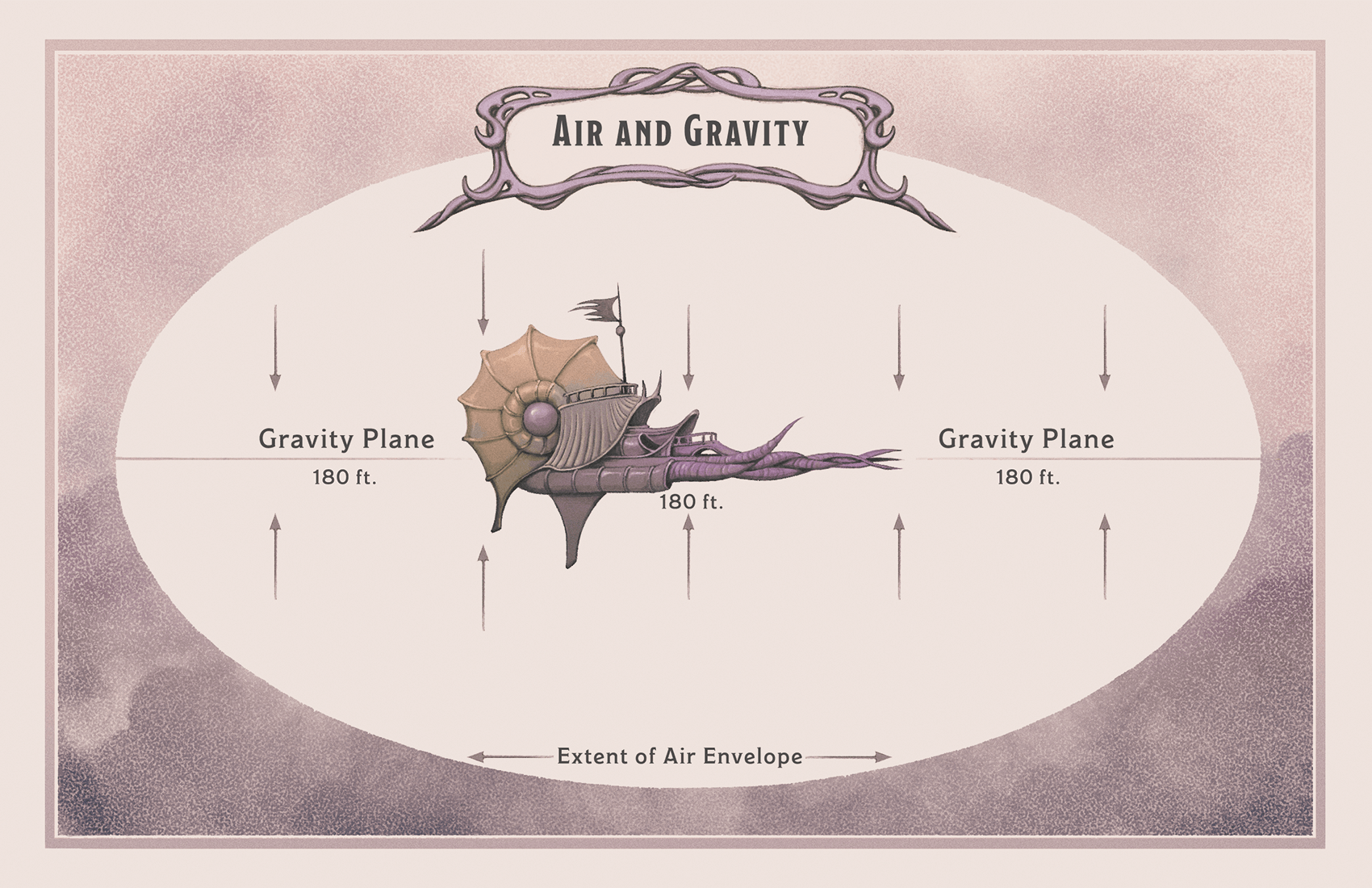
Gravity Planes
Much like breathable air, gravity also works differently in the void of Wild Space compared to the real world. First of all, gravity is the force that allows every object and creature to pull enough air along with it through space to create Air Envelopes.
Secondly, in Spelljammer, gravity “is an accommodating force, in that the direction of its effect seems to be ‘that which is most convenient.’” Hilariously hand-wavy as this is, I honestly don’t mind the writers taking this rather practical approach, rather than desperately trying to generate a sense of verisimilitude around gravity. Instead, kids’ movie rules apply, which is a big contributor to how well Spelljammer captures the feeling of media like Treasure Planet, old Doctor Who, and Time Bandits.
As depicted above, objects that are smaller than planets or big asteroids, like ships, don’t emanate gravity from their center, but rather emit a plane that cuts them in half and extends as far out as their air envelope. Also, because of the strange properties of a gravity plane, an object or creature that falls off the side of a ship can end up oscillating back and forth across the gravity plane, dropping down until it crosses the plane, then “falling” back up again, before repeating the process indefinitely — at least, until it drifts out of the ship’s Air Envelope and gets left several thousands of miles behind it in a matter of seconds.
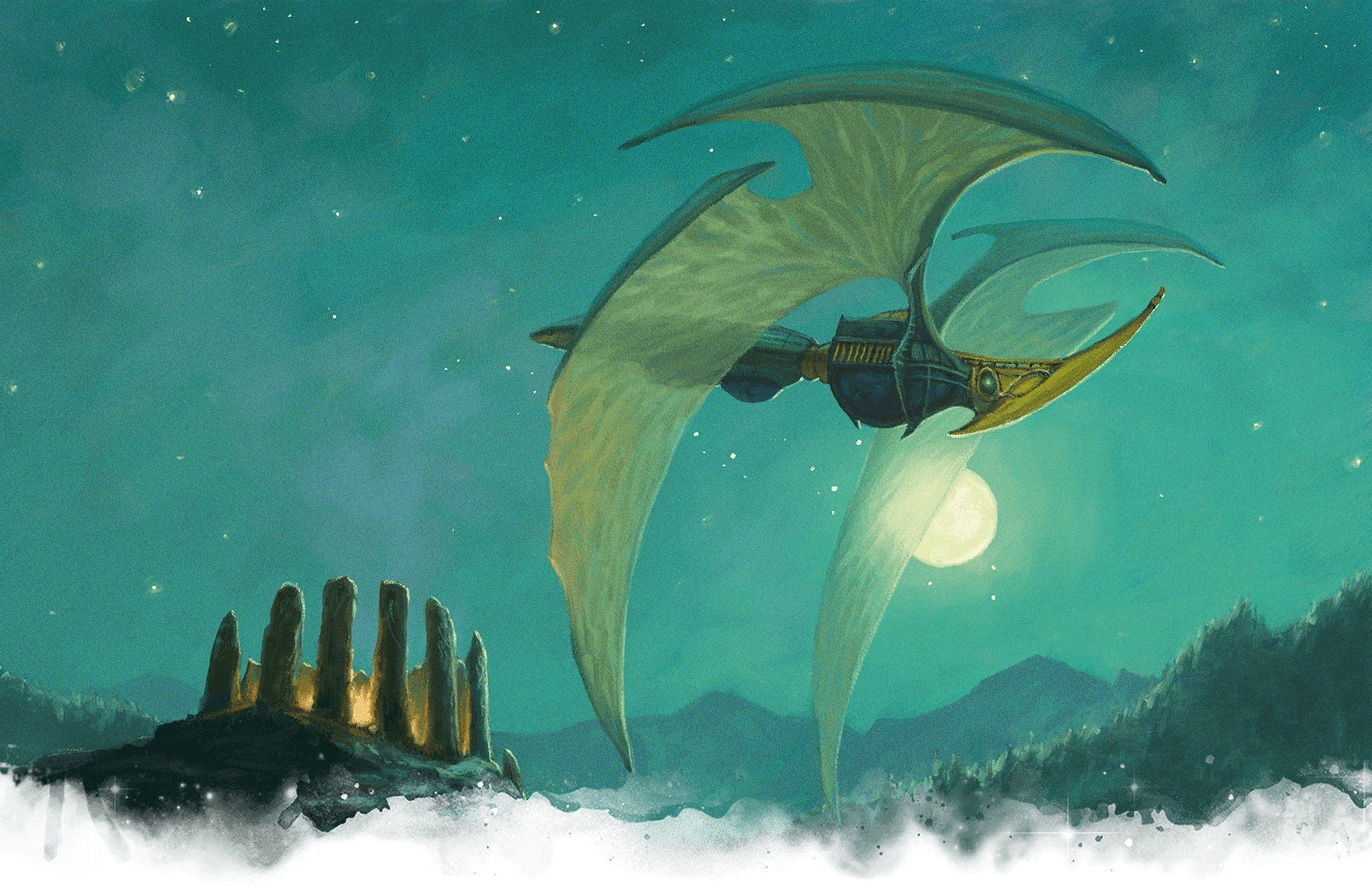
Ships of Spelljammer
Spelljamming Ships come in all shapes and sizes. Some, like the Space Galleon, function more or less identically to mundane ships from the material plane — with the exception of being able to blast off from the water and away into space.
Others — like the tentacle-festooned Nautiloids piloted by mind flayers or the giant deep space spider ships piloted by the Neogi — are decidedly alien contraptions that have no business anywhere but the deepest reaches of the void. Many spelljamming ships resemble insects or fish (there’s even one amphibious model that looks like a turtle); others are made from the bodies of dead monsters and gods or have living treants growing through their hulls.
Of course, as weird and wondrous as spelljamming ships are, they’re nothing compared to the people who crew them.
Races of Spelljammer
Spelljammer might be D&D 5e’s most diverse setting to date (at least, until Planescape comes out next year) and has officially (re-)introduced a full six playable character races to the game in addition to two new backgrounds specifically tailored to adventures in Wildspace and on the Astral Sea: the Astral Drifter and Wildspacer.
What’s especially cool about these new backgrounds is that they also confer mechanical advantages that express your character’s familiarity with life in space. Both backgrounds get a free feat at 1st level as well as some really fun thematic changes. The Astral Drifter, for example, is 20d6 years older than they look thanks to time spent not aging on the Astral Sea and gets the Magic Initiate feat thanks to a brush with an entity of cosmic power.
The six new races introduced to the game in Spelljammer include:
Astral Elf
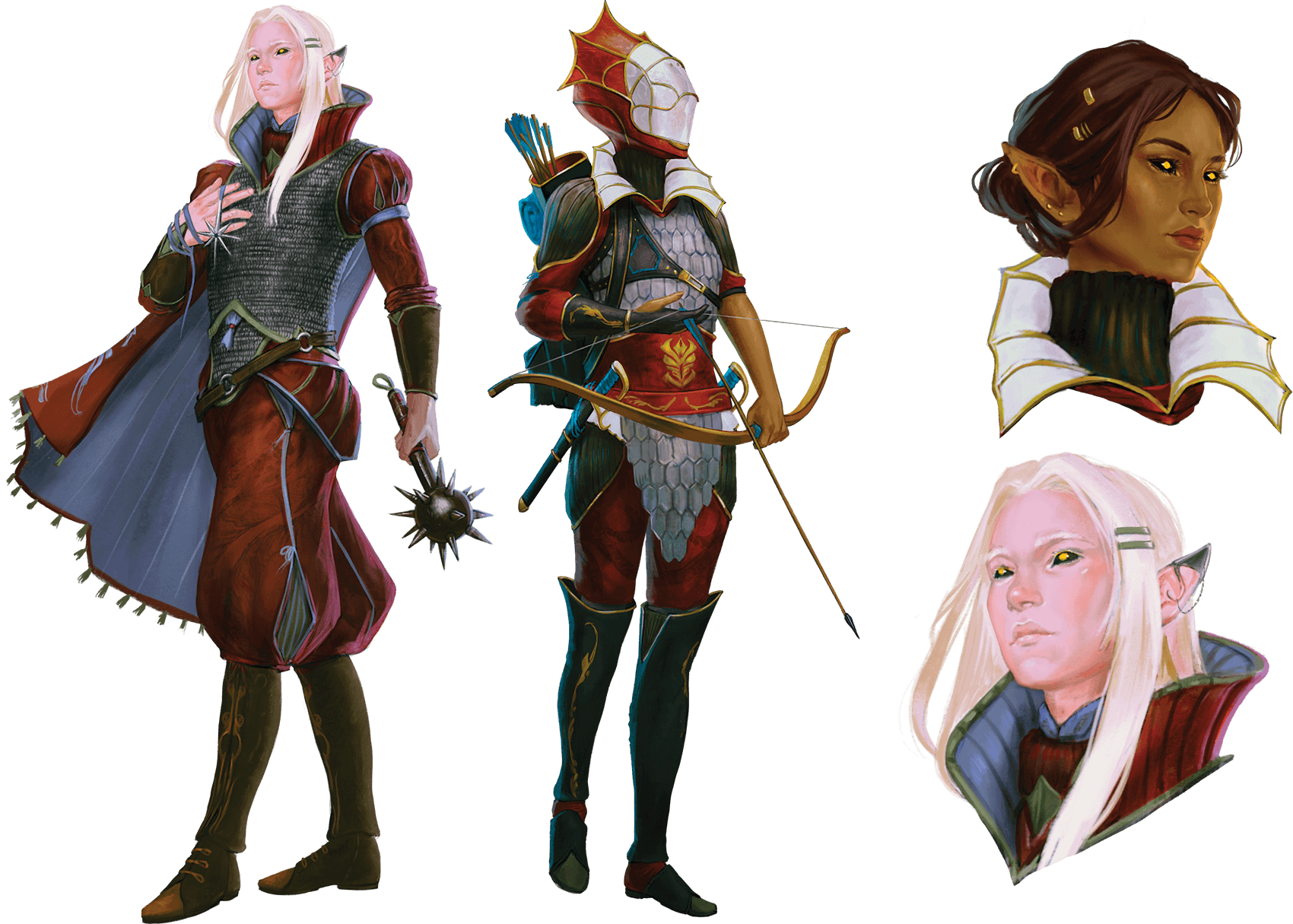
Over the centuries, all elves (whether they be Wood Elves, Sea Elves, Drow, Eladrin, etc.) take on characteristics of their environment. Astral Elves have spent long enough in the Astral Plane (even longer than an elf’s naturally elongated life) that they have been transformed by it, picking up the ability to gain new proficiencies by meditating and teleporting short distances.
Autognome

These are mechanical gnomes that have gained free will, originally built by rock gnomes but now free to explore the universe. Like other constructs, Autognomes are healed by the mending spell, but they also benefit from the effects of traditional magical healing.
Giff
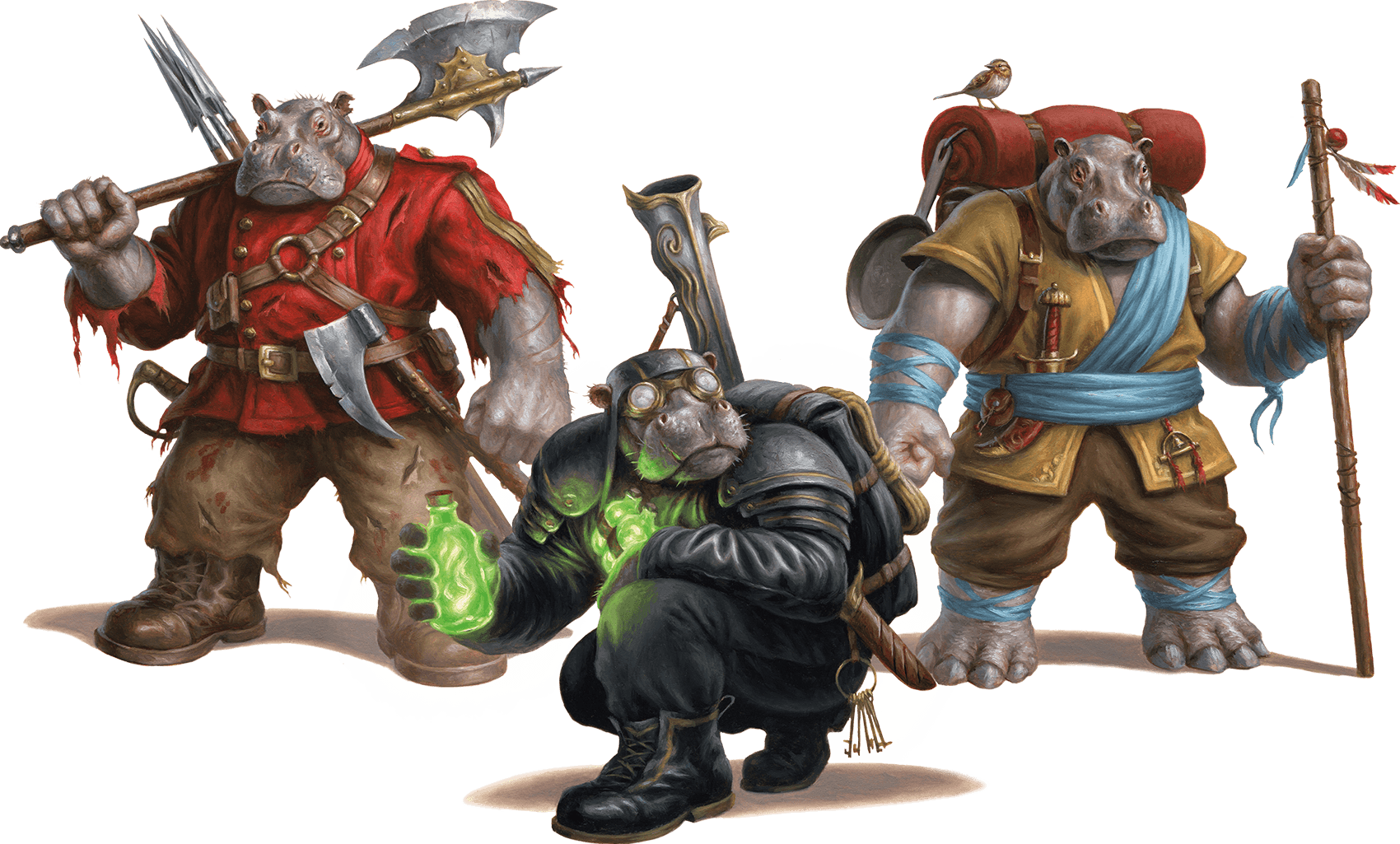
Mighty, hippo-headed folk of impressive size, the Giff don’t actually know where they come from or who created them. However, their kind finds themselves drawn to the Astral Plane by their ancestral connection to the gods that created them and imbued them with powerful attacks and a natural affinity for guns.
Hadozee

These are monkey-like beings that were created as the result of a wizard’s experimental attempts to create a race of super soldiers he could sell to the highest bidder. The Hadozee rebelled, won their freedom, and have adapted well to the hazards of Wildspace.
They have membranes of skin hanging from their arms and legs that they can use to glide, feet just as dextrous as their hands, and a natural resilience to damage.
Plasmoid
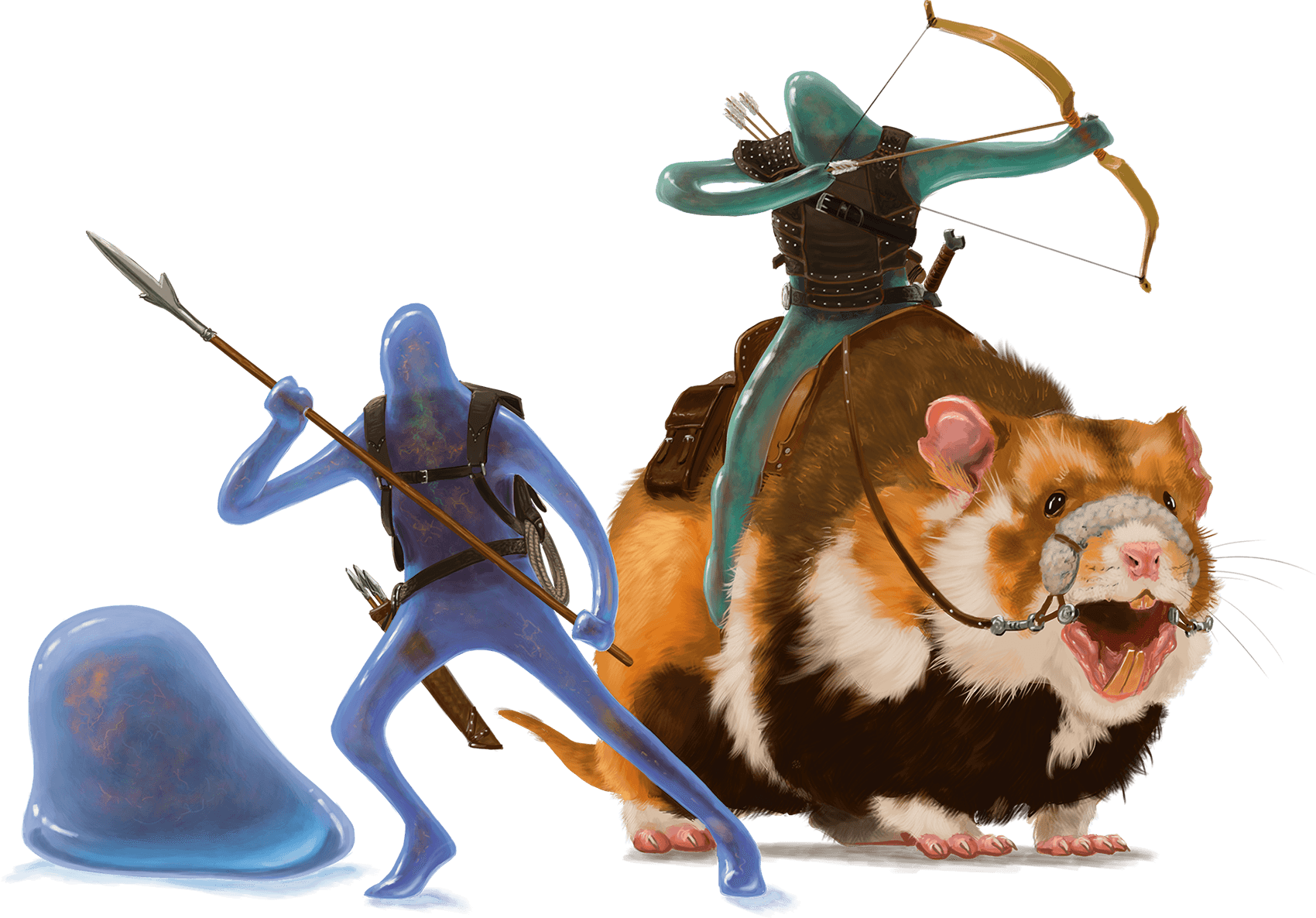
D&D 5e’s first playable ooze, Plasmoids are amoeba-like entities that can squeeze through tiny spaces, have resistance to acid and poison damage, and form their slimy, amorphous bodies into facilities of humanoids. (Yeah, basically you’re Odo from Deep Space 9).
They can also extend a gelatinous pseudopod with a 10-foot range that functions similarly to a Mage Hand.
Thri-Kreen
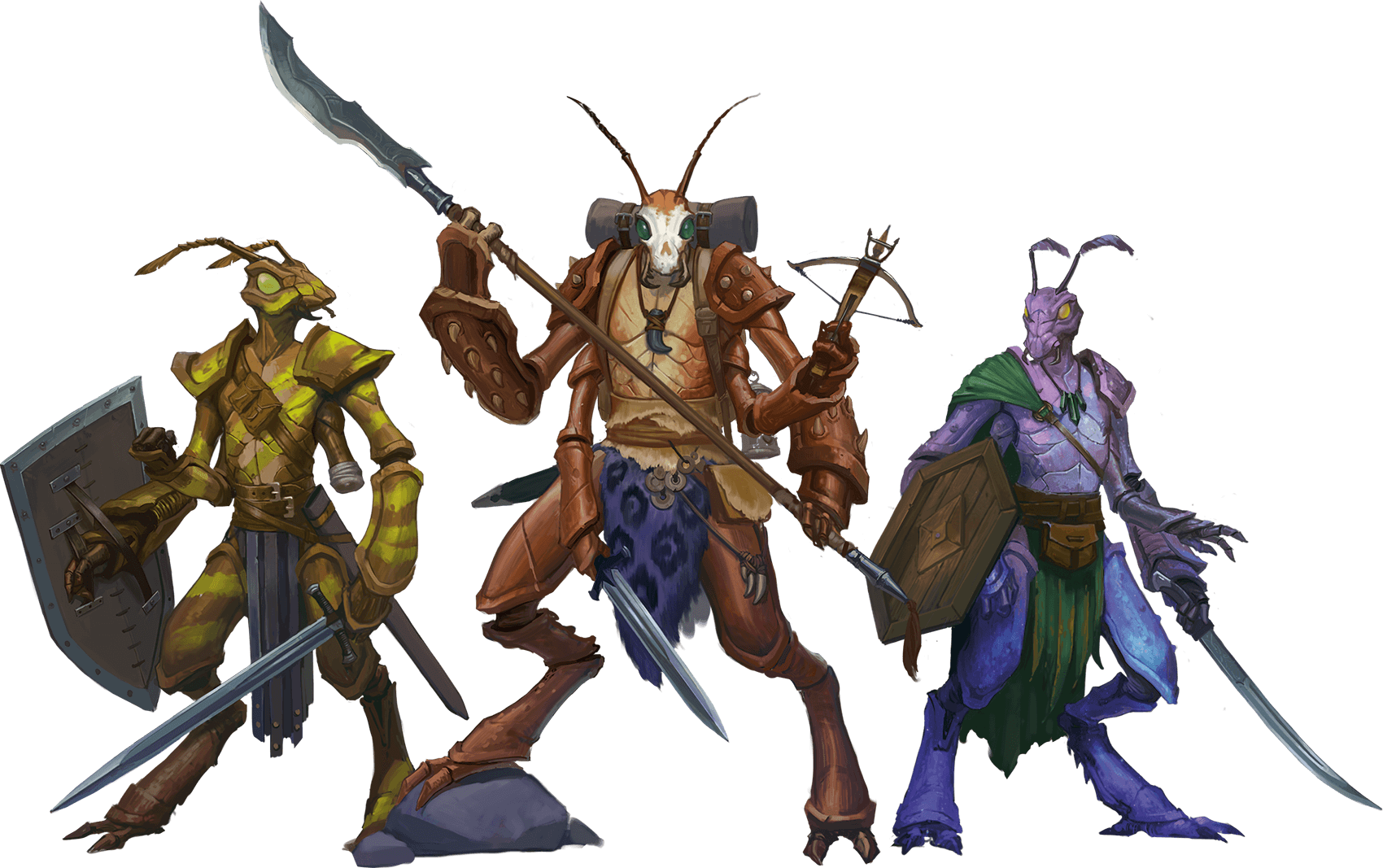
Insectile beings originally from the Dark Sun setting, these “mantis men” are encased in protective chitin that they can also use to camouflage themselves in their surroundings. While they can only speak in a series of baffling clicks and waving antennae, all Thri-Kreen are also telepathic.
They also do not require sleep and have a pair of secondary arms capable of performing additional tasks.
Final Thoughts
Spelljammer represents a return of D&D 5e to some of the iconic campaign settings of 2e with Dragonlance and Planescape also on the horizon.
It’s a great big weird multiverse out there, and whether you want to tangle with killer clowns flying ships that shoot deadly custard pies, plunder the fossilized bodies of long-dead gods, or just get to where you’re going in relatively the same condition you left, the realm of Spelljammer represents an exciting way to do it.
I played my first tabletop RPG (Pathfinder 1e, specifically) in college. I rocked up late to the first session with an unread rulebook and a human bard called Nick Jugger. It was a rocky start but I had a blast and now, the better part of a decade later, I play, write, and write about tabletop RPGs (mostly 5e, but also PBtA, Forged in the Dark and OSR) games for a living, which is wild.
